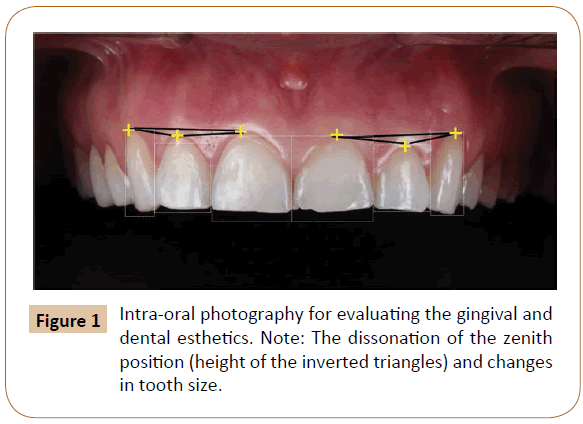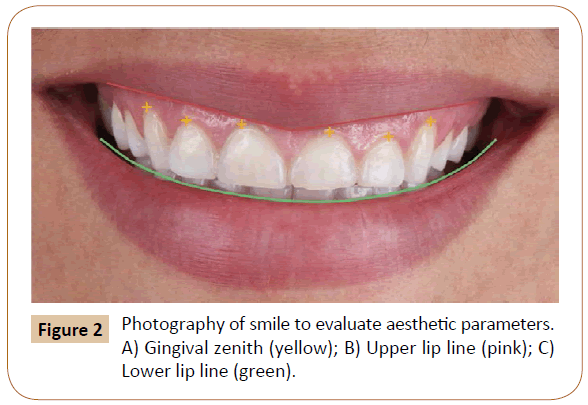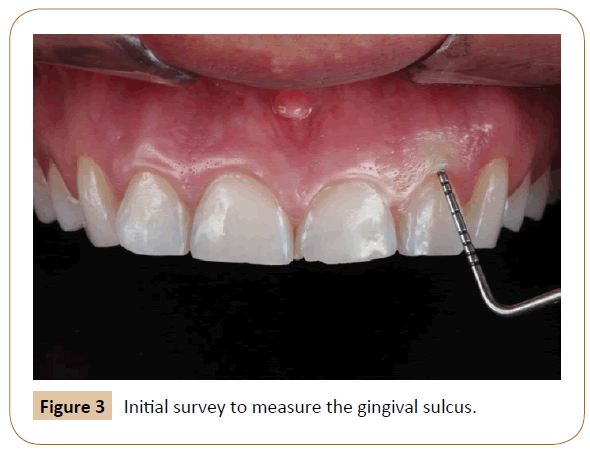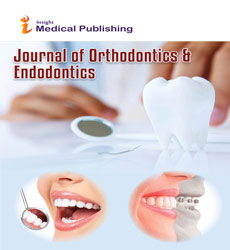Gingival Zenith as a Reference for Bonding Braces
Hortência Lopes de Souza Lisita, Milena Moraes de Oliveira Lenza, Eduardo Beaton Lenza and Maurício Guilherme Lenza
DOI10.21767/2469-2980.100052
Hortência Lopes de Souza Lisita*, Milena Moraes de Oliveira Lenza, Eduardo Beaton Lenza and Maurício Guilherme Lenza
Instituto Lenza/Faculdade Suldamérica, Goiânia – GO, 74180-010, Brazil
- *Corresponding Author:
- Hortência Lopes de Souza Lisita
Instituto Lenza – Pós Graduação. Av. Americano do Brasil
904 - St. Marista, Goiânia – GO, 74180-010, Brazil
Tel: (5562) 3095-1022
E-mail: hortencialopes@hotmail.com
Received Date: March 24, 2018; Accepted Date: April 09, 2018; Published Date: April 16, 2018
Citation: de Souza Lisita HL, de Oliveira Lenza MM, Lenza EB, Lenza MG (2018) Laser Update in Endodontics. J Orthod Endod 4:3. doi: 10.21767/2469-2980.100052
Abstract
Orthodontics for adults is the current reality of many practices since the greater accessibility of orthodontic treatment lately. The association of orthodontics with prosthetic rehabilitation is a frequent scenario and requires an adequate multidisciplinary interaction to aim not only orthodontic alignment but also the treatment of other needs. Often, orthodontic planning is one of the steps in the oral rehabilitation and the ortho-periotic interaction is present in the idealization of a harmonious smile. Thus, the techniques of orthodontic leveling should be adapted to the individuality of the patient and the proposal of oral rehabilitation. When there is a need for prosthetic finishing, gingival collage can equalize the zenith line and periodontal aesthetic. The present study aims at the elaboration of a manual to guide orthodontists in the bonding of braces using as a reference the reconstruction of an ideal gingival contour.
Keywords
Orthodontics; Esthetics; Orthodontic appliances
Introduction
The position of the braces in orthodontic treatment should consider the need for corrections at the gingival level, prosthetic level, or both. With the diffusion of the orthodontic treatment in the adults and increase in the needs of complementary treatment to orthodontics, the technique of bonding the braces using as reference the gingival contour is highlighted.
In modern clinical practice, orthodontic treatment aims to provide a functional occlusion and smile esthetics interacting several specialties in the patient planning. In addition, in recent decades there has been an increase in the search for orthodontic treatments in adult patients with the aim of improving aesthetics and masticatory function [1-3].
In this group, it is common to associate dental problems such as gingival recessions, tooth wear, old restorations, periodontal bone defects, edentulous spaces, gingival level difference and a variety of other problems that may influence treatment [1,3-5].
A multidisciplinary team is essential for adequate planning aiming not only for orthodontic alignment but also the treatment of other needs. The complaint of the patients as well as their financial limitations, biological restrictions, and systemic diseases should be considered to profile, thus avoiding future replanning [5,6].
Typically, the preferred technique of choice for braces bonding uses as a reference the incisal portion of the anterior teeth or the center of the crown, since the age profile of orthodontic patients were children and adolescents [3,5,7]. Currently, the collage of braces by zenith is an orthodontic preparation option for leveling that requires prosthetic rehabilitation. In this case, the position of the braces favors the construction of the gingival architecture correlating aesthetic principles of the smile, correcting height of the zenith and providing a periodontal aesthetic for posterior prosthetic reconstruction [5,6,8].
This paper aims to create a guide for orthodontists for bonding brackets using zenith as a reference in the reconstruction of an ideal gingival contour.
Orthodontic Gengival Leveling Guide
The need to expand the knowledge of orthodontist about gingival aesthetics in orthodontic planning became essential as the frequency of dental care in adult dental offices increased. Before beginning orthodontic treatment, multidisciplinary planning is essential and knowledge of aesthetic concepts by the orthodontist is required to base its planning [5].
Aesthetic Parameters
Gingival zenith
It is the most apical point of the gingival tissue of the anterosuperior teeth, generally displaced distal to the midline. The union of the zeniths of the canine, lateral and central teeth should form an inverted triangle where the zenith of the canine is slightly higher than the zenith of the central, and the zenith of the lateral lower than the zeniths of canine and central (Figures 1 and 2) [2,5,8].
Upper lip line
It is the demarcation line through the upper lip contour Figure 2. This line determines the red aesthetic (gingival). The gingival margins should be parallel to the upper lip line [5,8].
Lower lip line
It is the line demarcated through the contour of the lower lip Figure 2. This line determines the white aesthetics (teeth). The incisal edges of the upper teeth should accompany the curvature of the upper edge of the lower lips, thus determining the smile arc or smile curve [5,8-10].
Indications
Indications for this technique are:
1. Incisional fractures of the dental crown.
2. Tooth wear.
3. Short clinical crowns with alteration of the gingival level.
4. Bone defects in one or two dental walls in aesthetic region.
Materials
For orthodontic planning with the technique of bracket bonding using as a reference the reconstruction of an ideal gingival contour the following items are necessary:
1. Orthodontic documentation (photos, radiographs, plaster models of the dentition).
2. Periodontal probe.
3. Dry-tip compass with millimeter ruler.
Operating Procedures
1. Evaluation of aesthetic parameters
Orthodontic documentation is used to analyze the aesthetic parameters to be considered in the planning as well as the clinical evaluation and use of photographic records to evaluate smile height and reference lines [2,5] as detailed in Table 1. Then, it is necessary to survey the front teeth with a periodontal probe to verify the need for periodontal treatment expert to increase clinical crown or grafts prior to orthodontic treatment (Figure 3).
| S.No. | Aesthetic Parameters |
|---|---|
| 1. | Evaluate the dental proportion through clinical evaluation, orthodontic documentation and complementary photographs. |
| 2. | Evaluate the height of the smile and the reference lines (lower lip line and incisal tooth contour, upper lip line and contour of the gingival levels). |
| 3. | Perform depth of probing and determine the need for periodontal corrections prior to or after orthodontic treatment. |
| 4. | Establish dental planning complementary to orthodontics. |
Table 1: Sequence of aesthetic parameters to be evaluated.
2. Braces bonding technique
After defining orthodontic planning, the vertical measurements should be made to position the brackets of the anterior elements from the gingival zenith with a periodontal probe using a millimeter ruler or using a dry point compass (Figure 4). In cases where the gingival margin is not aligned and there is a gingival enlargement that will be corrected later, the groove is standardized to 1 mm for the appropriate measurements [5].
When the appropriate gingival height is indicated, considering or not gingival recession, the "X" of each tooth (vertical positioning) is calculated. The determination of the "X" of the canine follows the usual techniques and may use the center of the clinical crown or the incisal portion. To find the position of the lateral incisor should be subtracted 1 mm, and for the central incisor should be subtracted only 0.5 mm from the "X" of the canine [5-7]. The bonding sequence of the braces is described in Table 2.
| S.No. | Braces Bonding Sequence | |
|---|---|---|
| 1. | Probe front teeth | Consider 1 mm for gingival sulcus |
| 2. | Define gingival reference of each dent | Consider gingival surgery or grafts |
| 3. | Determine the "X" of the canines | The reference may be the posterior braces bonding or 1 mm above the point of contact or traditional technique using clinical crown center or incisal measuring |
| 4. | Braces bonding upper lateral incisors | From the gingival contour X-1 mm |
| 5. | Braces bonding upper central incisors | From the gingival contour X-0,5 mm |
Table 2: Braces bonding sequence.
Discussion
The increase in preventive oral health in recent years has allowed a smaller number of people to become edentulous in adulthood. In addition, factors such as the requirement of aesthetic standards in contemporary society associated with greater accessibility of orthodontics have resulted in a greater demand for orthodontic treatment by adults [1].
However, the orthodontist has problems beyond the alignment of teeth such as precarious restorations, edentulous spaces, worn teeth, fractured teeth, bone defects, changes in the gingival level, missing teeth and periodontal problems [1,11]. Whenever possible the rehabilitation planning should be performed by a multidisciplinary team to determine the references that will be used by the orthodontist to direct the prosthetic and periodontal options to be performed as well as to solve the complaints of the patient with a thorough clinical analysis of all the dental aspects [2,3,5].
A close relation between the orthodontist and the periodontist is fundamental to determine when and how to correct the periodontal problems before the bonding of the braces, since the orthodontic movement must be performed in a healthy periodontium [1,11]. Orthodontics provides benefits for patients with some periodontal impairment because tooth movement may eliminate the need for surgical corrections such as increased crown or gingival grafts, improves the aesthetic relationship of gingival levels and may in some cases correct "black spaces" between anterior teeth, which are usually challenges for the periodontist and for the prosthetic rehabilitator [1].
For many years, with the advent of the straight-wire, the bonding of the braces was based on the center of the clinical crown resulting in a straight or flattened smile rather than the curvature of the smile in the final result [12]. Modifications of bonding techniques were subsequently suggested to form the arc smile when there is no compromise of the incisor teeth allowing a dominance of the central incisors and creating a more harmonious smile [9]. The reference using the center of the clinical crown is a good choice for prosthetic rehabilitation of patients since dental reconstruction and recoating or gingival recontouring occur prior to orthodontic treatment. In cases where the smile exhibits periodontal or gingival defects concomitantly with fractures, wear or alteration in the dental shape, the bonding of the orthodontic accessories using gingival zenith as a reference is a viable option to obtain the gingival leveling and then proceed to prosthetic rehabilitation [5,10].
In contrast, patients with low smile line in which the gingival architecture does not expose the presence of gingival contour discrepancies does not require correction, as this condition is aesthetically irrelevant [1,2,10]. Before the bonding of the brackets, the periodontal probing is essential to establish the references to be followed [1,6]. The periodontal probe should be inserted into the linear depression and forced apically towards the cementoenamel junction, thus the marginal gingiva can be separated from the dental surface by determining the gingival sulcus. Measurement of the clinical groove is defined by the addition of the groove epithelium with the junctional epithelium. When healthy, it measures from 1 to 3 mm and does not present bleeding [5,13,14].
To associate orthodontics with periodontics in the treatment of patients with bone defects of one or two dental walls in aesthetic region may favor tissue gains in regions of papillae using slow orthodontic extrusion [1,5]. This technique can also be used for condemned teeth [5,15]. In this case, the tooth with bone loss allows close to cervical collections during extrusion by performing the vertical displacement of the element to be extracted, which favors the tissue gain of the gingival [10,15]. For cases of recessions that do not involve areas of papilla or bad tooth position, previous periodontal graft to the orthodontic treatment may favor the result of gingival health since certain movements as expansion of the dental arch may increase the gum recession [5].
In the presence of clinical gingival sulcus measuring more than 3 mm and absence of periodontal disease, it is recommended the removal of the gingival excess before bonding braces. However, in cases where patients have short crowns, it is preferable to plan tooth intrusion in order to bring the whole periodontal apparatus to the apical despite the increase of clinical crown. In this way, dental preparation will be performed in a region of dental enamel allowing a better adhesion and longevity of the prosthetic rehabilitations [5]. The new dental position and gingival configuration after orthodontic intrusion should be stabilized for at least six months for the periodontal fibers to reorganize [1,10]. Another clinical condition that should be carefully evaluated by the orthodontist is the presence of high insertions of the labial frenulum because they favor retractions during the orthodontic movement [9].
At present new strategies of braces bonding are reflexes of the personalized orthodontics, which the strategies must be individualized to the demands of the patient and not focused on the use of previously established prescriptions. Thus, the orthodontist can not be oblivious to the new concepts of aesthetics practiced by other specialties, especially for that patient who will undergo a rehabilitation treatment.
Conclusion
The evaluation of gingival architecture and aesthetic parameters should be routine in orthodontist planning. In addition, a multidisciplinary interaction is important for better targeting of treatment and correction of associated problems.
Bracket bonding techniques should be individualized for each patient. The use of gingival zenith as a reference is an alternative in the orthodontic treatment of patients with indication of posterior prosthetic rehabilitation.
References
- Kokich VG (2005) Adult orthodontic in the 21st century: guidelines for achieving successful results. World J Orthod 6: 14-23.
- Seixas MR, Costa-Pinto RA, de Araújo TM (2012) Gingival esthetics: an orthodontic and periodontal approach. Dental Press J Orthod 17: 190-201.
- Vianna VF, Mucha JN (2006) O posicionamento vertical dos acessórios na montagem do aparelho ortodôntico fixo. Rev Dent Press Ortodon Ortop Facial 11: 66-75.
- Buttke TM, Proffit WR (1999) Referring adult patients for orthodontic treatment. J Am Dent Assoc 130: 73-79.
- Romanelli J, Melo A (2016) Estética Gengival composta pela Integração Orto-Perio. In. Ortodontia Estética – uma visão multidisciplinar 25-46.
- Carinhena GF (2014) Colagem em zênites para o sorriso. In. Ortodontia autoligada- Mecânicas contemporâneas do sistema autoligado passivo. Protocolos de tratamento 55-95.
- McLaughlin RP, Bennett JC (1995) Bracket placement with the preadjusted appliance. J Clin Orthod 29: 302-311.
- Câmara CALP (2006) Estética em Ortodontia: Diagramas de Referências Estéticas Dentárias (DRED) e Faciais (DREF). Rev Dent Press Ortodon Ortop Facial 11: 130-156.
- Barbosa JÁ, Caran CSB (2014) Smile arc no sistema autoligável. Colagem progressiva de braquetes. Rev Dent Press Ortodon Ortop Facial 13: 62-80.
- Brandão RCB, Brandão LBC (2013) Finishing procedures in Orthodontics: dental dimensions and proportions (microesthetics). Dental Press J Orthod 18: 147-174.
- Kokich VG (2003) Excellence in Finishing: Modifications for the Perio-Restorative Patient. Seminars in Orthodontics 9: 184-203.
- Andrews LF (1989) Straigth-Wire – The concept and the appliance. LA Wells Co, San Diego, United States.
- Carranza FA (1983) Periodontia Clínica de Glickman, 5th Edition, Rio de Janeiro: Interamericana, 968.
- Lindhe J, Lang NP, Karring T (2010) Tratado de Periodontia Clínica e Implantologia Oral, 5th Edition, Rio de Janeiro: Guanabara Koogan, 1304.
- Janson MRP, Passanezi E, Janson RRP, Pinzan A (2002) Tratamento interdisciplinar II: estética e distância biológica: alternativas ortodônticas para remodelamento vertical do periodonto. Rev Dent Press Ortodon Ortop Facial 7: 85-105.
Open Access Journals
- Aquaculture & Veterinary Science
- Chemistry & Chemical Sciences
- Clinical Sciences
- Engineering
- General Science
- Genetics & Molecular Biology
- Health Care & Nursing
- Immunology & Microbiology
- Materials Science
- Mathematics & Physics
- Medical Sciences
- Neurology & Psychiatry
- Oncology & Cancer Science
- Pharmaceutical Sciences




